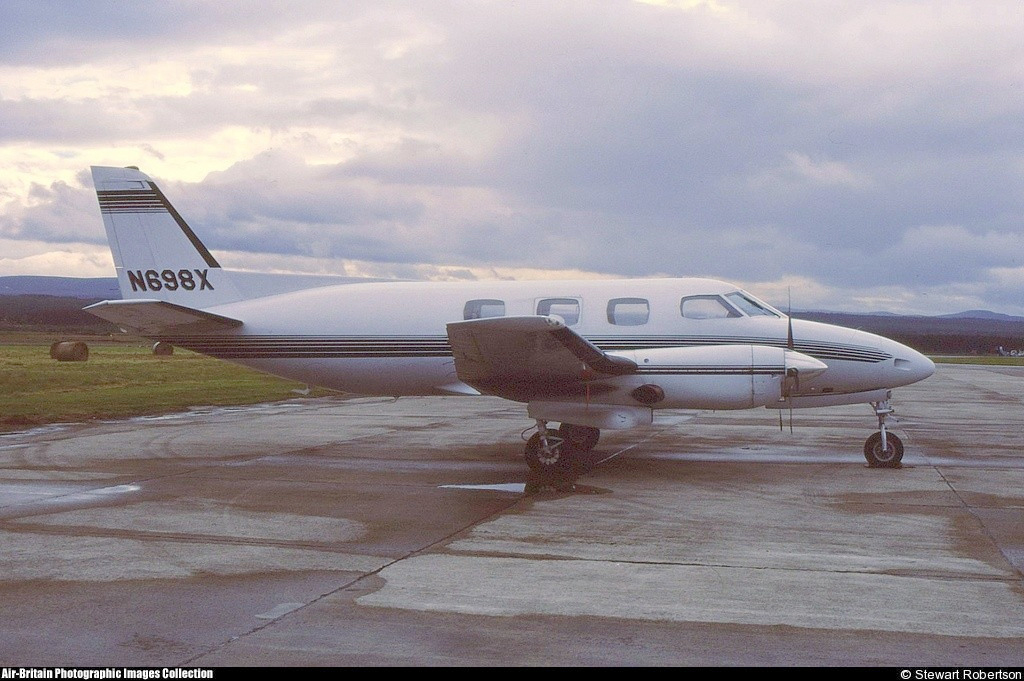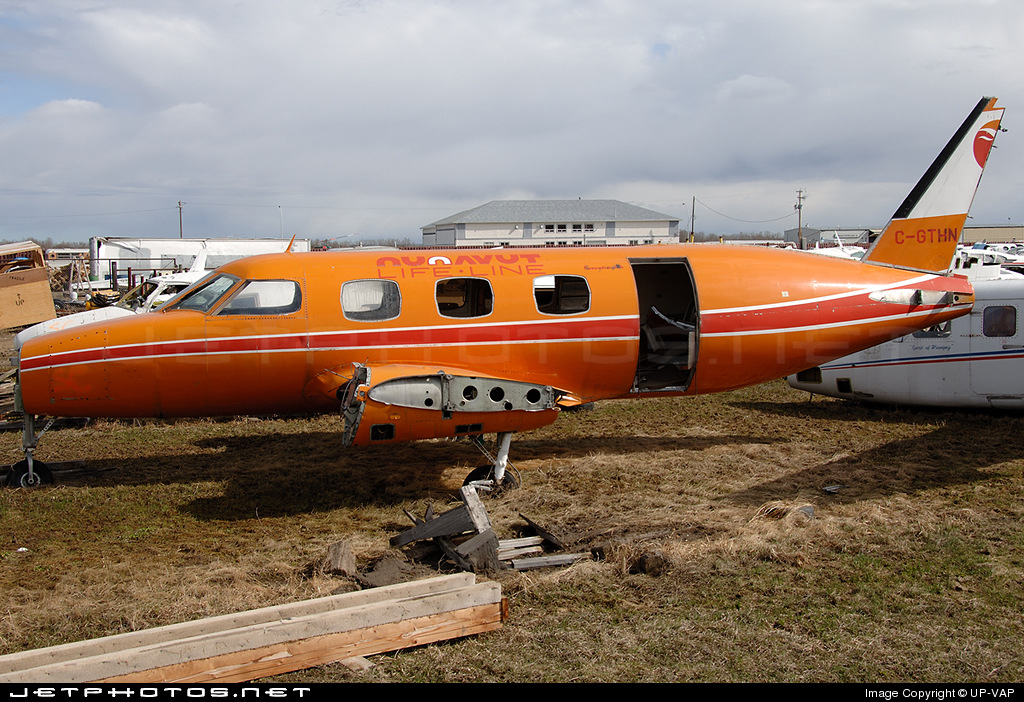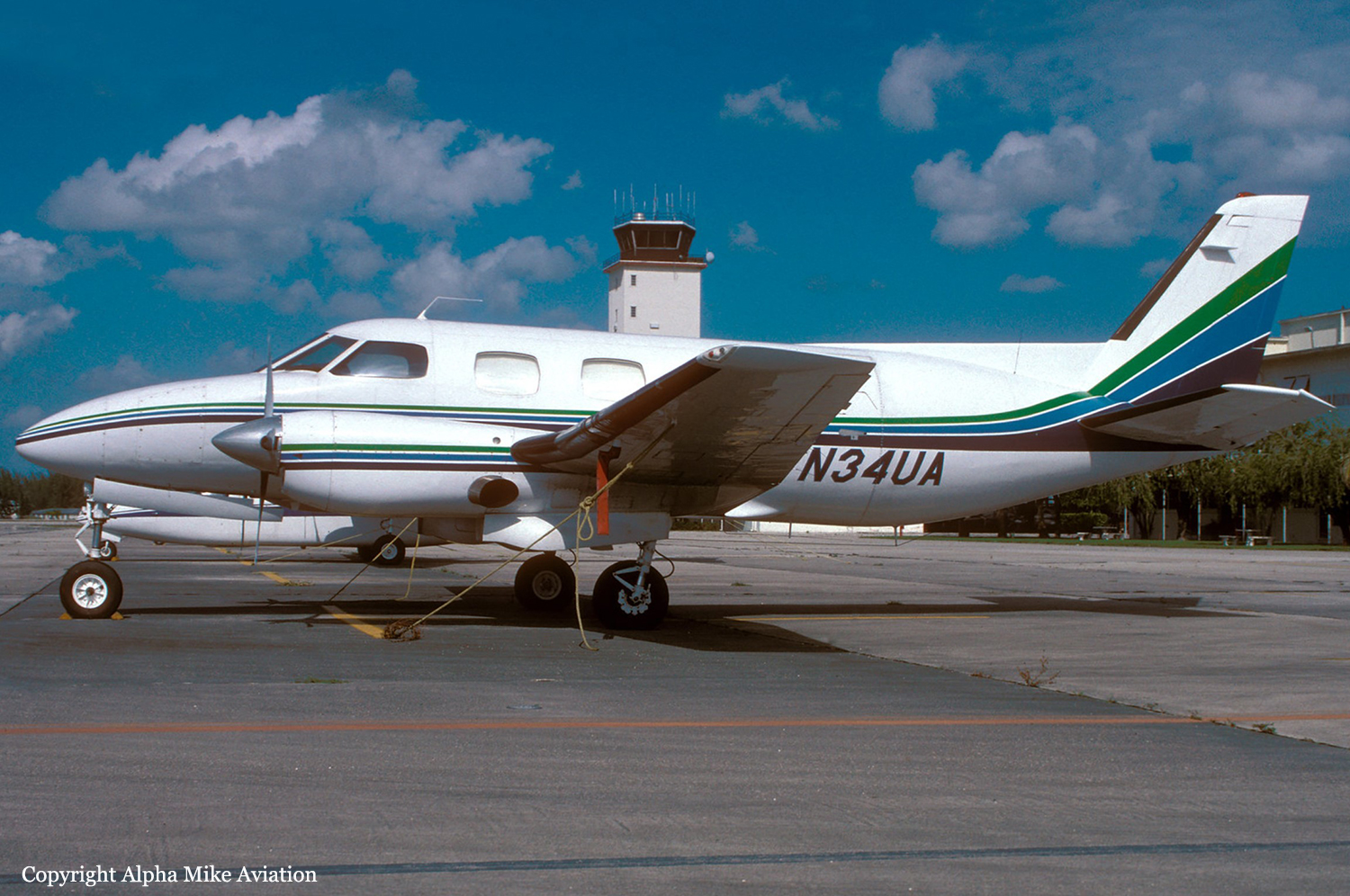Country
Crash of a Swearingen SA26AT Merlin IIB in Lawrenceville
Date & Time:
Apr 26, 2005 at 1826 LT
Registration:
N50KV
Survivors:
Yes
Schedule:
Spartanburg – Lawrenceville
MSN:
T26-115
YOM:
1968
Crew on board:
1
Crew fatalities:
Pax on board:
1
Pax fatalities:
Other fatalities:
Total fatalities:
0
Captain / Total hours on type:
3500.00
Aircraft flight hours:
9415
Circumstances:
While executing an instrument approach to land on runway 25, the airplane collided with the runway, and collapsed the right main landing gear. The airplane subsequently burst into flames after the pilot and passenger exited the airplane. Post-accident examination of the engines found both the left and right engine fuel controls in a low power setting. Examination of the propeller control found both propellers at 30-degrees. The pilot did not report any flight control or mechanical problems during flight.
Probable cause:
The pilot's improper landing flare that resulted in a hard landing.
Final Report:
Crash of a Swearingen SA26AT Merlin IIB in Jacksonville: 1 killed
Date & Time:
Nov 27, 2003 at 0752 LT
Registration:
N698X
Survivors:
Yes
Schedule:
Beaumont – Jacksonville
MSN:
T26-137
YOM:
1969
Crew on board:
1
Crew fatalities:
Pax on board:
4
Pax fatalities:
Other fatalities:
Total fatalities:
1
Aircraft flight hours:
8263
Circumstances:
The pilot was on an instrument flight from Beaumont, Texas, to Craig Airport, Jacksonville, Florida. According to the pilot's children who were passengers on the airplane, the pilot knew the destination airport was forecast to have fog upon their arrival. Air traffic controllers informed the pilot east of Tallahassee, Florida, the fog at his destination airport would not lift for at least an hour and a half. The pilot was informed the weather at Saint Augustine, Florida, was clear skies with two miles visibility. The pilot informed the controller that he would slow the airplane and continue to Craig. The pilot was subsequently cleared to descend and provided vectors for the ILS Runway 32 approach at Craig. The pilot informed the controller that he had the current automatic terminal information service (ATIS) information. The ATIS for Craig reported an indefinite ceiling with a vertical visibility of 100 feet, and one-quarter of a mile visibility. The weather minimums for the ILS runway 32 approach is a decision height of 241 feet, and one-half mile visibility. The controller informed the pilot to contact Craig Tower. The pilot contacted Craig Tower, and was instructed to report passing the final approach fix. The controller informed the pilot that Jacksonville International Airport had a runway visual range of more than 6,000 feet, and that airplanes were making it in. The controller asked the pilot what his intentions were in the event he made a missed approach. The pilot replied, "I got my brother bringing my mom there into your airfield, so I do not know, what do you think is best, what's closest." The controller replied Jacksonville was closer than Saint Augustine. The pilot informed the controller that he would go to Jacksonville in the event of a missed approach. The pilot was cleared to land, and there was no further radio contact between the pilot and Craig Tower. The airplane was located a short time later in a wooded area, 1.8 miles from the airport. Postaccident examination of the airplane revealed no preimpact mechanical anomalies.
Probable cause:
The pilot's descent below decision height while performing an ILS approach with low ceilings and fog, resulting in an in-flight collision with trees and the ground. A factor associated with the accident was the pilot's decision to attempt the instrument approach with weather below the prescribed minimums.
Final Report:

Crash of a Swearingen SA26T Merlin IIB in Saint George: 2 killed
Date & Time:
Jul 7, 1998 at 1547 LT
Registration:
N501FS
Survivors:
No
Schedule:
Anchorage - Saint George
MSN:
T26-146
YOM:
1969
Crew on board:
2
Crew fatalities:
Pax on board:
0
Pax fatalities:
Other fatalities:
Total fatalities:
2
Captain / Total hours on type:
250.00
Aircraft flight hours:
7799
Circumstances:
The flight departed Anchorage, Alaska, and was en route to Saint George, Alaska, to pick up passengers for a return flight to Anchorage. The pilot-in-command (PIC) was seated in the right seat, and the copilot was seated in the left seat. This was the copilot's third flight in this make and model airplane, and he was not qualified as a crewman in it under 14 CFR Part 135. There was no record of when the copilot last performed a non directional beacon (NDB) approach. The NDB indicator in the cockpit was on the left side of the left control column, partially blocked from the view of the PIC. The minimum altitude for the segment of the approach prior to the final approach fix (FAF) was 1,700 feet. The Minimum Descent Altitude (MDA) for the final segment of the approach was 880 feet. The reported ceiling was 100 feet overcast. The Air Route Traffic Control Center radar altitude readout for the airplane revealed that the airplane descended below 600 feet prior to reaching the FAF. The radar ground track revealed the airplane on course prior to the course reversal procedure turn on the published approach. The radar ground track showed that after the course reversal, the airplane continued through the published final approach course, and turned to parallel the inbound track three miles north of course. The radar plot terminates about the location of the 550 feet high cliffs where the airplane was located. Weather at the time of the accident was reported as 100 foot overcast. This location was 5.5 miles (DME) from the airport. A review of radar tapes from the day prior to the accident, show the same airplane and PIC tracking the published course outbound and inbound, and descending below the published approach minima to below 500 feet. This flight successfully landed at the airport. An interview with the copilot from the successful flight revealed that the PIC intentionally descended to 300 feet on the approach until he acquired visual contact with the ocean, then flew to the airport to land. An aircraft flying on the published inbound final approach course at 5.5 DME is over water, approximately three miles from the nearest terrain.
Probable cause:
The pilot-in-command's failure to adequately monitor the instrument approach and the copilot's failure to intercept and maintain the proper NDB bearing on the approach. Contributing factors were the pilot-in-command's obstructed view of the NDB indicator and his overconfidence in his personal ability, the terrain (cliffs), low ceiling, and the flight crew's disregard of the minimum descent altitude.
Final Report:
Crash of a Swearingen SA26T Merlin IIA in Whale Cove
Date & Time:
Jun 20, 1996 at 1905 LT
Registration:
C-GTHN
Survivors:
Yes
MSN:
T26-016
YOM:
1968
Crew on board:
2
Crew fatalities:
Pax on board:
0
Pax fatalities:
Other fatalities:
Total fatalities:
0
Circumstances:
After landing at Whale Cove Airport, the aircraft deviated to the left after a course of about 1,600 feet. It veered off runway, lost its undercarriage and came to rest. Both pilots escaped uninjured while the aircraft was damaged beyond repair.
Probable cause:
The aircraft deviated from the runway centerline after landing due to strong crosswinds gusting up to 31 knots. The certification limit for the aircraft in such conditions was 22 knots.

Crash of a Swearingen SA26T Merlin IIA in Thompson: 2 killed
Date & Time:
Jun 1, 1994 at 0001 LT
Registration:
C-FFYC
Survivors:
Yes
Schedule:
Coral Harbour – Churchill – Thompson
MSN:
T26-36
YOM:
1969
Crew on board:
2
Crew fatalities:
Pax on board:
1
Pax fatalities:
Other fatalities:
Total fatalities:
2
Captain / Total hours on type:
3160.00
Copilot / Total hours on type:
375
Aircraft flight hours:
12633
Circumstances:
The twin-engine turboprop aircraft had just completed a medical evacuation (MEDEVAC) flight from Coral Harbour, Northwest Territories (NWT), to Churchill, Manitoba. At 2257 central daylight saving time (CDT), the aircraft departed Churchill for a night, instrument flight rules (IFR) flight to return to the aircraft's base of operations at Thompson, Manitoba. The en route portion of the return leg was conducted at an altitude of 18,000 feet above sea level (asl). Approximately one hour after take-off, the aircraft commenced an approach to the Thompson Airport. The crew remained in radio contact with air traffic control (ATC) personnel until approximately 2359 CDT. Just after midnight (0001 CDT), the Hotel non-directional beacon (NDB), which is located 3.4 miles northeast of the Thompson Airport, stopped transmitting. Ninety minutes later, the search and rescue satellite system (SARSAT) picked up an emergency locator transmitter (ELT) signal to the northeast of the airport. Thompson Airport staff, who had been dispatched to the site of the failed navigation beacon, found the wreckage of the aircraft in and around the NDB transmitter compound. Emergency responses were initiated by various airport and local authorities.
Probable cause:
The flight crew lost altitude awareness during the localizer back course approach and allowed the aircraft to descend below a mandatory level-off altitude. Contributing factors to this occurrence were the crew's deviation from a published approach procedure, ineffective in-flight monitoring of the approach, rapidly developing localized fog conditions, and, probably, pilot fatigue.
Final Report:
Crash of a Swearingen SA26T Merlin II in Winchester: 1 killed
Date & Time:
Mar 18, 1994 at 0050 LT
Registration:
N20PT
Survivors:
No
Schedule:
Washington DC - Winchester
MSN:
T26-128
YOM:
1969
Crew on board:
1
Crew fatalities:
Pax on board:
0
Pax fatalities:
Other fatalities:
Total fatalities:
1
Captain / Total hours on type:
568.00
Aircraft flight hours:
5869
Circumstances:
While on approach at night, in VMC, the left engine lost power due to fuel starvation. The propeller was not feathered, the l/g was left down, and the aircraft drifted left of crs, struck trees, and then the ground. One gallon of fuel was drained from the right wing, engine and fuel line. No fuel was found in the left wing, engine and fuel line. The copilot said the fuel quantity system was erratic with the left side more erratic, and the right side reading about 10 gallons more than the left side. Testing found the right side indicated about 45 gallons more than was present while the left side was inoperative. There was no requirement for periodic recalibration of the fuel quantity system. The owner/pilot had operated the aircraft on 32 flights, over 23 hours, and refueled 23 times using partial fills, since he had full tanks. The pilot was checked out 17 months prior and the instructor said the pilot was fine, however, he was cautioned him to enroll in recurrent training. There was no record he did. The pilot had received an FAA checkride 19 months prior to the accident, which he passed.
Probable cause:
The pilot's decision to operate the airplane with known deficiencies in the fuel quantity measuring system which resulted in a power loss due to fuel starvation, followed by improper emergency procedures which resulted in a loss of control inflight and uncontrolled contact with the ground. Factors were the lack of a requirement for periodic calibration of the fuel quantity measuring system from the manufacturer, and the erratic and inaccurate fuel quantity measuring system.
Final Report:
Crash of a Swearingen SA26AT Merlin IIB in Ardmore
Date & Time:
Feb 10, 1993 at 1645 LT
Registration:
N34UA
Survivors:
Yes
Schedule:
Lindale - Ardmore
MSN:
T26-145
YOM:
1969
Crew on board:
1
Crew fatalities:
Pax on board:
0
Pax fatalities:
Other fatalities:
Total fatalities:
0
Captain / Total hours on type:
25.00
Circumstances:
During a missed approach the airplane lost power to both engines. The pilot selected the only area available to land. The terrain was marked by trees, fences, and rising terrain. Prior to the missed approach the airplane had landed at another airport in the same town. The purpose of the flight was to ferry the airplane to a facility to repair a fuel leak in the wing.
Probable cause:
Pilot's failure to refuel and fuel exhaustion. Factors were a fuel leak in the wing and unsuitable terrain.
Final Report:

Crash of a Swearingen SA26T Merlin II in Glenwood Springs
Date & Time:
Feb 13, 1992 at 2055 LT
Registration:
N26JB
Survivors:
Yes
Schedule:
Grand Junction - Denver
MSN:
T26-163
YOM:
1969
Crew on board:
1
Crew fatalities:
Pax on board:
4
Pax fatalities:
Other fatalities:
Total fatalities:
0
Captain / Total hours on type:
750.00
Aircraft flight hours:
3988
Circumstances:
The pilot of the air ambulance feathered the right propeller after reporting 'a bit of a problem' with the right engine. He attempted to divert to the nearest suitable airport, but after receiving its latest weather report, elected to return to base. The airplane made a left turn, reentered IMC, and impacted a mountainside on a magnetic heading of 092°. The heading to the airport of intended landing was 272°. The accident occurred during a snowstorm at night. All five occupants survived and were rescued the following afternoon. Thick grease on the right engine fuel control camshaft prevented a spring from returning the 3d cam to a lower altitude position. The cam was found struck on the shaft at a position equating to an altitude of approximately 15,000 feet. The fuel flow schedule for flight idle was below specifications. In addition, shroud material was found delaminated from the left engine second stage compressor housing.
Probable cause:
Malfunction of the right engine fuel control that caused the engine to flame out, and delamination of the left engine compressor shroud. Factors were: the pilot became disoriented, the mountainous terrain, the dark night, and the weather conditions.
Final Report:
Crash of a Swearingen SA26T Merlin IIB in Monongahela
Date & Time:
Oct 12, 1990 at 1545 LT
Registration:
N690X
Survivors:
Yes
Schedule:
Monongahela – Pittsburgh – Teterboro – Pittsburgh – Monongahela
MSN:
T26-141
YOM:
1969
Crew on board:
1
Crew fatalities:
Pax on board:
0
Pax fatalities:
Other fatalities:
Total fatalities:
0
Captain / Total hours on type:
21.00
Circumstances:
The flight was from Monongahela to Pittsburgh to Teterboro, NJ, then return to Pittsburgh and back to Monongahela. The flight departed Monongahela with 100 gallons of fuel; 160 gallons were added at Pittsburgh; and 80 gallons were added at Teterboro. The pilot wanted to add more fuel at Teterboro but the owner did not due to the higher cost of fuel and the fuel gage indications. During the return trip no fuel was added at Pittsburgh because the pilot did not have a credit card provided by the owner or money to buy fuel. The flight experienced a two-engine power loss due to fuel exhaustion while approaching the Monongahela Airport. Subsequent examination of the cockpit fuel gages showed a total of 125 gallons in the left tank and 90 gallons in the right tank; the reading remained the same with or without power.
Probable cause:
The pilot's inadequate monitoring of the fuel burn which resulted in total fuel exhaustion. Factors which contributed to the accident were: the pilot's limited experience in the make and model of airplane, an erroneous fuel quantity indication, and the pilot's failure to refuel the airplane due to pressure from the owner to not add fuel.
Final Report:


